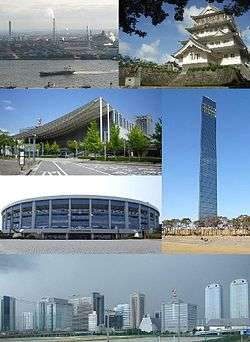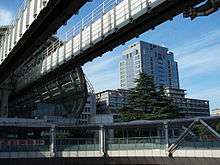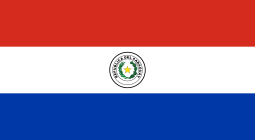Chiba (city)
Chiba (千葉市, Chiba-shi, Japanese: [tɕiꜜba]) is the capital city of Chiba Prefecture, Japan. It sits about 40 kilometres (25 mi) southeast of the centre of Tokyo on Tokyo Bay.[1] Chiba City became a government-designated city in 1992. In June 2019, its population was 979,768, with a population density of 3,605 people per km2. The city has an area of 271.77 square kilometres (104.93 sq mi).
Chiba 千葉市 | |
|---|---|
 Top: Coastal industrial area, Chiba Folk Museum Middle: Makuhari Messe, Chiba Port Tower, Chiba Marine Stadium Bottom: Skyscrapers of Makuhari on the coast. | |
 Flag | |
%26groups%3D_716e187db43e6ef70cae7d8d2e3c8e619fe58078.svg)
| |
 Location of Chiba in Chiba Prefecture | |
 Chiba | |
| Coordinates: 35°36′26.2″N 140°06′22.9″E | |
| Country | |
| Region | Kantō |
| Prefecture | Chiba Prefecture |
| Government | |
| • Mayor | Toshihito Kumagai |
| Area | |
| • Total | 271.77 km2 (104.93 sq mi) |
| Population (June 1, 2019) | |
| • Total | 979,768 |
| • Density | 3,600/km2 (9,300/sq mi) |
| Time zone | UTC+9 (Japan Standard Time) |
| -Tree | Zelkova serrata |
| – Flower | Nelumbo nucifera |
| – Bird | Little tern |
| Phone number | 043-245-5111 |
| Address | 1-1 Chiba-minato, Chūō-ku, Chiba-shi 260-8722 |
| Website | https://www.city.chiba.jp/ |
| Chiba | |||||
|---|---|---|---|---|---|
"Chiba" in kanji | |||||
| Japanese name | |||||
| Kanji | 千葉 | ||||
| Hiragana | ちば | ||||
| Katakana | チバ | ||||
| |||||
Chiba City is one of the Kantō region's primary seaports, and is home to Chiba Port, which handles one of the highest volumes of cargo in the nation. Much of the city is residential, although there are many factories and warehouses along the coast. There are several major urban centres in the city, including Makuhari, a prime waterfront business district in which Makuhari Messe is located, and Central Chiba, in which the prefectural government office and the city hall are located.
Chiba is famous for the Chiba Urban Monorail, the longest suspended monorail in the world. Some popular destinations in the city include: Kasori Shell Midden, the largest shellmound in the world at 134,000 m2 (160,000 sq yd), Inage Beach, the first artificial beach in the nation which forms part of the longest artificial beach in Japan, and the Chiba City Zoological Park, popular on account of the standing red panda Futa.
Etymology
The name of Chiba in the Japanese language is formed from two kanji characters. The first, 千, means "thousand" and the second, 葉 means "leaves". The name first appears as an ancient kuni no miyatsuko, or regional command office, as the Chiba Kuni no Miyatsuko (千葉国造).[2] The name was adopted by a branch of the Taira clan, which moved to the area in present-day Chiba City in the late Heian period. The branch of the Taira adopted the name and became the Chiba clan, which held strong influence over the area of the prefecture until the Azuchi–Momoyama period. The name "Chiba" was chosen for Chiba Prefecture at the time its creation in 1873 by the Assembly of Prefectural Governors (地方官会議, Chihō Kankai Kaigi), an early Meiji-period body of prefectural governors that met to decide the structure of local and regional administration in Japan.[3]
History
Early history
The first records related to the city of Chiba record the emigration of Taira Tsuneshige (1083?–1088), a powerful bushi warlord of the late Heian period, to Shimōsa Province, which historically occupied the north of Chiba Prefecture. Tsuneshige was appointed as gunji administrator of Sōma District, but was transferred to the same position in Chiba District two years later. Here he proclaimed himself Chiba Tsuneshige (千葉常重), became a kokushi governor of the province, and used the area around present-day Chiba City as a power base to rule over Shimōsa Province, Kazusa Province, as well as establish himself as a military force in the Kantō region.[4] Tsuneshige's son, Chiba Tsunetane (千葉常胤) (1118–1201) was instrumental in aiding Minamoto no Yoritomo (1147–1199) with the establishment of the Kamakura shogunate. Tsuneshige built a spacious residence and numerous temples in present-day Chiba City, and in the same period he transferred his power base from Ōji Castle to Inohana Castle on Mount Inohana.[5] The area of present-day Chiba City became jōkamachi (城下町), or castle town, and prospered under the Chiba clan.[6] The clan's power extended in the region until the Muromachi period.[7][8]
Medieval period
The Chiba clan's power and influence declined because of wars around the Kantō region during the Nanboku-chō and Muromachi periods. In the 16th century, instead of the Chiba clan, the Hara clan, which was one of the servants of Chiba clan, wielded power in this region. In the Sengoku period, the Hara clan was forcibly removed by Ashikaga Yoshiaki (足利義明, not to be confused with 足利義昭). Then, Ashikaga Yoshiaki was also removed by the Sakai (酒井 not to be confused with the Sakai clan in Mikawa) clan, which was one of the servants of the Satomi (里見) clan. Finally both the Chiba and Sakai clans were annihilated by Toyotomi Hideyoshi.
Later history
In the Edo period, the Oyumi (生実氏), Morikawa (森川氏) clan, and the Sakura (佐倉氏) clans governed the area now occupied by the city. A part of the area was also governed directly by the Tokugawa Bakufu. The Oyumi clan governed their territory stably. On the other hand, according to the Sakura clan, from the beginning of the Edo period, changed governors frequently, including Takeda Nobuyoshi, Matsudaira Tadateru, Ogasawara Yoshitsugu (小笠原吉次), and Doi Toshikatsu. Finally the Hotta clan stabilized the governance of their territory. Chiba prospered in this period as a shukuba (宿場) post-town of the Tokugawa shogunate.[6]
Modern history
After the Meiji Restoration in 1868 and the advent of the railroad in Japan, Chiba became the political, economic, and cultural capital of Chiba Prefecture. The town of Chiba was established within Chiba District with the creation of the municipalities system on April 1, 1889. Chiba City formed on January 1, 1921.[6] Numerous small villages and towns were merged into the previous town of Chiba (千葉町), a process that continued until 1944. Large-scale land reclamation added to the area of the city throughout the 20th century. The city was a major center of military production leading up to World War II, and as such, was a target of aerial bombing by the United States. The city was almost completely destroyed by the end of the war. Post-war industrialization led to the city becoming a major part of the Keiyō Industrial Zone.[6] Chiba became a Designated City of Japan on April 1, 1992.[1]
Demographics
As of February 2016, the city had an estimated population of 972,861 and a population density of 3,580 persons per km2. The total area of the city is 271.76 km2 (104.93 sq mi). There were 19,135 registered foreign residents in the city as of March 31, 2007, making up for about 2% of the total population. It is the 14th most populated city in Japan.
Politics and government

Chiba was governed by Keiichi Tsuruoka, an independent (elected with support of LDP and Kōmeitō), until May 1, 2009. He was arrested in April 2009 during a corruption investigation by the Tokyo Metropolitan Police. He was succeeded by Toshihito Kumagai of the DPJ, who won election in June 2009.[9]
The city assembly has 54 elected members.
Climate
Chiba has a humid subtropical climate (Köppen climate classification Cfa) with very hot summers and cool to mild winters. Precipitation is significant throughout the year, but is somewhat lower in winter.
| Climate data for Chiba, Chiba | |||||||||||||
|---|---|---|---|---|---|---|---|---|---|---|---|---|---|
| Month | Jan | Feb | Mar | Apr | May | Jun | Jul | Aug | Sep | Oct | Nov | Dec | Year |
| Average high °C (°F) | 9.8 (49.6) |
10.2 (50.4) |
13.2 (55.8) |
18.3 (64.9) |
22.3 (72.1) |
25.0 (77.0) |
28.6 (83.5) |
30.5 (86.9) |
26.9 (80.4) |
21.8 (71.2) |
16.9 (62.4) |
12.4 (54.3) |
19.6 (67.3) |
| Daily mean °C (°F) | 5.7 (42.3) |
6.1 (43.0) |
8.9 (48.0) |
14.0 (57.2) |
18.3 (64.9) |
21.3 (70.3) |
25.0 (77.0) |
26.7 (80.1) |
23.3 (73.9) |
18.0 (64.4) |
12.9 (55.2) |
8.3 (46.9) |
15.7 (60.3) |
| Average low °C (°F) | 1.9 (35.4) |
2.3 (36.1) |
5.0 (41.0) |
10.1 (50.2) |
14.8 (58.6) |
18.4 (65.1) |
22.3 (72.1) |
23.9 (75.0) |
20.5 (68.9) |
14.9 (58.8) |
9.2 (48.6) |
4.4 (39.9) |
12.3 (54.1) |
| Average precipitation mm (inches) | 59.6 (2.35) |
59.5 (2.34) |
110.0 (4.33) |
110.4 (4.35) |
112.5 (4.43) |
149.9 (5.90) |
122.5 (4.82) |
134.3 (5.29) |
200.4 (7.89) |
185.9 (7.32) |
91.0 (3.58) |
51.5 (2.03) |
1,387.5 (54.63) |
| Average snowfall cm (inches) | 3 (1.2) |
4 (1.6) |
1 (0.4) |
0 (0) |
0 (0) |
0 (0) |
0 (0) |
0 (0) |
0 (0) |
0 (0) |
0 (0) |
0 (0) |
8 (3.2) |
| Average relative humidity (%) | 55 | 57 | 63 | 68 | 72 | 79 | 80 | 78 | 78 | 73 | 67 | 59 | 69 |
| Mean monthly sunshine hours | 185.1 | 162.3 | 160.3 | 174.1 | 172.3 | 125.2 | 153.0 | 190.0 | 127.7 | 135.6 | 142.0 | 176.1 | 1,903.7 |
| Source: Japan Meteorological Agency | |||||||||||||
Culture
One of the many points of interest is the Experimental Station for Landscape Plants.
Facilities
- Chiba Zoo
- Makuhari Messe
Sports

Chiba plays host to the annual International Chiba Ekiden and the Chiba International Cross Country takes place just outside the city. Chiba Velodrome is located within the city. It also hosts the Bridgestone Open golf tournament.
Chiba is home to several professional sports teams, most notably:
| Club | Sport | League | Venue | Established |
|---|---|---|---|---|
| Chiba Lotte Marines | Baseball | Pacific League | Chiba Marine Stadium | 1950 |
| JEF United Ichihara Chiba | Football | J. League Division 2 | Fukuda Denshi Arena | 1946 |
Transportation
Airports
There is no commercial airport within city limits. Narita International Airport and Tokyo International Airport (Haneda) are the closest major airports.
Railway
The Chiba Urban Monorail runs through Chiba City. The major intercity railway stations are Chiba Station, (Sobu Line, Sotobō Line, Uchibo Line, Sōbu Main Line, Narita Line, transfer for Chiba Urban Monorail), Keisei Chiba Station (Keisei Chiba Line), and Soga Station, (Keiyō Line, Sotobō Line, Uchibo Line) all in Chūō-ku.
Education
Colleges and universities
- Chiba University
- Chiba Prefectural University of Health Sciences
- Kanda University of International Studies
- Tokyo Dental College
- Shukutoku University
- Keiai University
- Chiba Keizai University
- Tokyo University of Information Sciences
- The Open University of Japan
- Uekusa University
- Teikyo Heisei University (Chiba campus)
- Chiba Meitoku College
- Japan Christian Junior College
High schools
Chiba has 20 public high schools operated by the Chiba Prefectural Board of Education and two public high schools operated by the Chiba City Board of Education, including Inage Senior High School. There are also nine private high schools, including the Makuhari Junior and Senior High School.
Elementary and middle schools
Chiba has 114 public and one private elementary school and 59 public and one private middle school.
International schools
Hospitals and clinics
- Chiba Kaihin Hospital (Mihama-ku)
- Chiba University Hospital (Chuo-ku)
- Kashiwado Hospital (Chuo-ku)
- Tokyo Dental College Chiba Hospital (Mihama-ku)
- Koizumi Clinic (Hanamigawa-ku)
- Mizuno Clinic (Hanamigawa-ku)
- Hirayama Hospital (Hanamigawa-ku)
Twin towns – sister cities
Chiba is twinned with:
.svg.png)







Notable people
- Sawa Ishige, born in Shizuoka but moved to Chiba
- Ryuta Kawashima, born in Chiba in 1959
- Masaki Aiba, of Arashi
- Pata, of X Japan and Ra:IN
- Yukihiro of L'Arc-en-Ciel, from Chiba and a graduate of The Chiba University of Commerce
- Tomohisa Yamashita, of NEWS
- Naohito Fujiki, Japan Academy Prize-winning actor
- Natsuki Mizu, top star of Snow Troupe in the Takarazuka Revue
- Daiki Arioka, of Hey! Say! JUMP
- Shiho Fujita, better known as Sifow
- Mirei Kiritani, actress, model, news anchor
- Kentaro Miura, creator of Berserk
- Tsukasa Fushimi, creator of Oreimo
- Susumu Tadakuma, prominent electrical engineer and professor (retired) at Chiba Institute of Technology[13]
- Tao Okamoto, model
- Reina Fujie of NMB48
- Cho Chikun, Go-player and Honorable citizen of Chiba City (1996).[14]
- Shiina Natsukawa, pop idol and member of girl group TrySail
- Mitsuhiro Hidaka, rapper and member of co-ed group AAA
See also


References
- "Archived copy" 千葉市 [Chiba-shi]. Nihon Rekishi Chimei Taikei (日本歴史地名大系 (in Japanese). Tokyo: Shogakukan. 2012. Archived from the original on 2007-08-25. Retrieved 2012-04-10.
- 千葉国造(下総). nihonjiten.com (in Japanese).
- 千葉県の成立と行政的変遷. Nihon Rekishi Chimei Taikei (日本歴史地名大系) (in Japanese). Tokyo: Shogakukan. 2012. Archived from the original on 2007-08-25. Retrieved 2012-04-01.
- 千葉常重 [Chiba Tsuneshige]. Nihon Jinmei Daijiten (日本人名大辞典) (in Japanese). Tokyo: Shogakukan. 2012. Archived from the original on 2007-08-25. Retrieved 2012-04-10.
- 千葉常胤 [Chiba Tsunetane]. Nihon Jinmei Daijiten (日本人名大辞典) (in Japanese). Tokyo: Shogakukan. 2012. Archived from the original on 2007-08-25. Retrieved 2012-04-10.
- "Chiba". Encyclopedia of Japan. Tokyo: Shogakukan. 2012. Archived from the original on 2007-08-25. Retrieved 2012-04-10.
- "Chiba". Encyclopedia of Japan. Tokyo: Shogakukan. 2012. Archived from the original on 2007-08-25. Retrieved 2012-02-27.
- 千葉氏 [Chiba-shi]. Kokushi Daijiten (国史大辞典) (in Japanese). Tokyo: Shogakukan. 2012. Archived from the original on 2007-08-25. Retrieved 2012-04-10.
- DPJ-backed Kumagai takes Chiba mayoral election, Japan Times Online, June 15, 2009
- "International Exchange". List of Affiliation Partners within Prefectures. Council of Local Authorities for International Relations (CLAIR). Archived from the original on 4 March 2016. Retrieved 21 November 2015.
- "The City of Houston, Houston Office of Protocol and International Affairs". Archived from the original on 2013-05-17.
- "Sister Cities". The Local Government of Quezon City. Archived from the original on 1 October 2017. Retrieved 9 April 2019.
- IEEE Richard H. Kaufmann Award Recipients: Sususmu Tadakuma
- "the Nihon Ki-in". Archived from the original on 2010-02-27. Retrieved 2015-06-27.
External links
| Wikimedia Commons has media related to Chiba, Chiba. |
| Wikivoyage has a travel guide for Chiba. |
- Official website (in Japanese)

